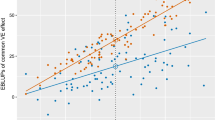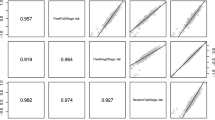Abstract
The versatility of mixed model procedures in investigating large, unbalanced sets of genotype by environment data is illustrated on an historic set of yields from a South Australian oat evaluation program. Information on specific genotypic traits is included in the analysis in order to isolate unexplained genotype by environment interaction.
Similar content being viewed by others
References
Aitken, M., 1987. Modelling variance heterogeneity in normal regression using GLIM. Appl Stat 36: 332–339.
Baker, R.J., 1996. Recent research on genotype-environmental interaction. In: G. Scoles & B. Rossnagel (Eds.), Proceedings of V International Oat Conference and VII International Barley Genetics Symposium, pp. 235–239.
Brown, P.D., R.I.H. McKenzie & K. Mi Kaelsen, 1980. Agronomic, genetic and cytologic evaluation of a vigorous new semi-dwarf oat. Crop Sci 20: 303–306.
Cochran, W.G. & G.M. Cox, 1957. Experimental Designs. 2nd ed. Wiley Press, New York.
Coffman, F.A., 1961 (Ed.). Oats and Oat Improvement. American Society of Agronomy, Madison, Wisc.
Cullis, B.R. & A.C. Gleeson, 1991. Spatial analysis of field experiments – an extension to two dimensions. Biometrics 47: 1449–1460.
Cullis, B.R., F.M. Thomson, J.A. Fisher, A.R. Gilmour & R. Thompson, 1996a. The analysis of the NSW wheat variety database. I. Modelling trial error variance. Theor Appl Genet 92: 21–27.
Cullis, B.R., F.M. Thomson, J.A. Fisher, A.R. Gilmour & R. Thompson, 1996b. The analysis of the NSW wheat variety database. II. Variance component estimation. Theor Appl Genet 92: 28–39.
Gabriel, K.R., 1971. The biplot graphic display of matrices with application to principal component analysis. Biometrika 58: 453–467.
Gauch, H.G., 1992. Statistical analysis of regional yield trials. Elsevier, Amsterdam.
Gilmour, A.R., R. Thompson & B.R. Cullis, 1995. AI, an efficient algorithm for REML estimation in linear mixed models. Biometrics 51: 1440–1450.
Gilmour, A.R., R. Thompson, B.R. Cullis & S. Welham, 1996. ASREML. Technical report, NSW Agriculture.
Gilmour, A.R., B.R. Cullis & A.P. Verbyla, 1997. Accounting for natural and extraneous variation in the analysis of field experiments. Journal of Agricultural, Biological and Environmental Statistics 2: 269–293.
Gleeson, A.C. & B.R. Cullis, 1987. Residual maximum likelihood (REML) estimation of a neighbour model for field experiments. Biometrics 43: 277–287.
James, A.T., W.N. Venables, I.B. Dry & J.T. Wiskich, 1994. Random effects and variances as a synthesis of nonlinear regression analysis of mitochondrial electron transport. Biometrika 81: 219–235.
Kempthorne, O., 1952. The Design and Analysis of Experiments. John Wiley & Sons, Inc.
Morrison, D.F., 1967. Multivariate Statistical Methods. McGraw-Hill.
Patterson, H.D. & R. Thompson, 1971. Recovery of interblock information when block sizes are unequal. Biometrika 31: 100–109.
Patterson, H.D., V. Silvey, M. Talbot & S.T.C. Weatherup, 1977. Variability of yields of cereal varieties in U.K. trials. J Agric Sci (Cambridge) 89: 239–245.
Rameau, C. & J.B. Denis, 1992. Characterization of environments in long-term multi-site trials in Asparagus, through yield of standard varieties and use of environmental covariates. Plant Breed 109: 183–192.
Searle, S.R., G. Casella & C.E. McCulloch, 1992. Variance Components. John Wiley & Sons, Inc.
Van Eeuwijk, F.A. & A. Elgersma, 1993. Incorporating environmental information in an analysis of genotype by environment interaction for seed yield in perennial ryegrass. Heredity 70: 447–457.
Van Eeuwijk, F.A., J.-B. Denis & M.S. Kang, 1995. Incorporating additional information on genotypes and environments in models for two-way genotype by environment tables. In: M.S. Kang & H.G. Gauch (Eds.), Genotype by Environment Interaction: New Perspectives, pp. 15–49. CRC Press, Boca Raton.
Van Eeuwijk, F.A., 1996. Between and beyond additivity and non-additivity; the statistical modelling of genotype by environment interaction in plant breeding. PhD Thesis, Wageningen, pp. 245–279.
Van Eeuwijk, F.A. & P.M. Kroonenberg, 1997. Multiplicative decompositions of interactions in three-way analysis of variance, with applications to plant breeding. Biometrics, submitted.
Williams, W.T., 1976. Pattern analysis in agricultural science. Elsevier, Amsterdam.
Zadoks, J.C., T.T. Chang & C.F. Konzak, 1974. A decimal code for the growth stages of cereals. Weeds Res 14: 415–421.
Author information
Authors and Affiliations
Rights and permissions
About this article
Cite this article
Frensham, A., Barr, A., Cullis, B. et al. A mixed model analysis of 10 years of oat evaluation data: use of agronomic information to explain genotype by environment interaction. Euphytica 99, 43–56 (1998). https://doi.org/10.1023/A:1018395731621
Issue Date:
DOI: https://doi.org/10.1023/A:1018395731621




